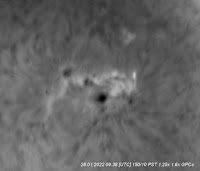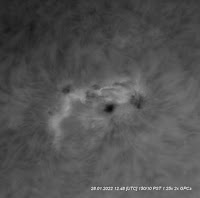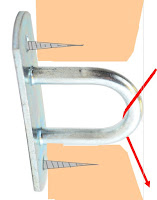*
Monday 31st. 36F overcast with brighter periods.
The positioning of the angle brackets, to hold the triangular, GRP patches in place, is quite critical. The large headed, galvanized bolts may match the rest, but their cosmetic appearance depends largely on symmetry.Of far more importance, the triangular patches also
have some very real, structural duties. In the vulnerable areas on either sides of
the slit. A hemisphere ought to be complete to enjoy maximum stiffness
and strength from its geometric form. Making a large hole and then calling it
an "observation slit" seriously weakens the structure.
Leaving large, triangular holes on either side of the slit is very bad form. The entire arc of the [foundation] base ring is missing unless supported by other means.
The
multiple wheels/rollers, which support the dome and allow it to rotate, cannot support fresh
air. The base ring alone has very limited stiffness over the open arc. The
slit ribs help of course. Within their limitations. They are rather widely
spaced and have little lateral stiffness without the help of the dome itself.
Hence all the angle brackets double bolted along the edges.
I have "guesstimated" the dome's weight at around 500kg. The fourteen rollers would each support ~36kg each. If the entire slit arc provides no serious resistance then the load per roller might easily rise to 50kg. Or much more. Depending on the flatness of the rest of the base ring.
Laminated plywood, glued in place and clamped is not a precision, flat surface. Though still, well within the load capacity of the rollers. The dome might become very difficult to turn. Or not turn as effortlessly as desired. I have repeatedly used the 360° laser level to check the ring for flatness. The large number of brackets holding it to the dome seem to help. My plywood dome relied only on the 8 ribs. With a little help from the cladding via some small screws. The base ring of that dome is more wavy than I'd like.
Serious problems arose when the underside of the base ring has been wet from rain leakage. I then have to apply all my weight to turn the dome by pushing on the ribs in turn. The friction roller just spins uselessly. Regardless of my increasing its loading by hanging from the 2x4 lever. Hopefully[!] the GRP dome will be fully waterproof. So the base ring will not become soaked and slippery.
That said, the inside of the GRP dome is already sweating when the conditions allow. Which is why I left an annular space behind the base ring. To allow any condensation to run freely down to the skirt and fall off into fresh air. Failing that, I may have to glue [waterproof] coarse abrasive paper to the underside of the base ring. That will have to wait until the dome is lifted into place.
*

















































